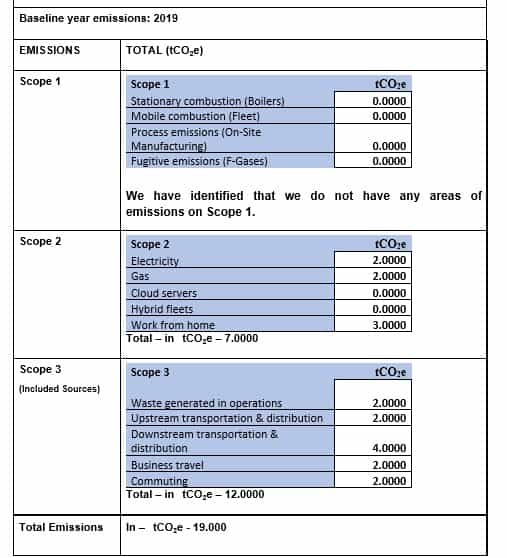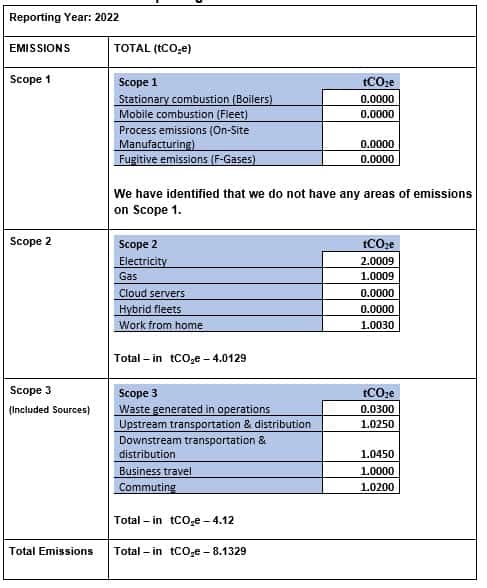Carbon Reduction Policy Plan v2.0
ICT Educational Services is committed to achieving Net Zero emissions by 2030.
Baseline Emissions Footprint
The year 2019 was the first time that ICT Educational Services assessed and reported on its carbon emissions.
Additional Details relating to the Baseline Emissions calculations:
The year 2019 was the first time that ICT Educational assessed and reported on its carbon emissions.
Baseline year emissions: 2019
Reporting Year: 2022
As we resumed normal operations once lockdown was lifted, we had an increase in emissions which we are looking to monitor and control. Our internal policy has made it mandatory for all staff to get training and we further enhance this by:
- Influencing and/or incentivise staff, suppliers, customers and communities to support environmental protection and improvement initiatives.
- We are currently looking to invest in the adoption and/or deployment of technologies that help reduce carbon emissions in service delivery across our entire supply chain.
- Investing in the monitoring and reporting of carbon emissions of our organisation, supply chain, and the solutions we deliver to the customer.
- environmental sustainability: promoting sustainable production and consumption and an improvement in environmental quality in support of the 25 year environment plan of the UK Government.
Emissions reduction targets
We have provided a table below to show our efforts in controlling emissions through continuous monitoring and careful application of methods of control within our organisation.
Carbon Reduction Projects
The following environmental management measures and projects have been completed or implemented since the 2019 baseline. The carbon emission reduction achieved by these schemes equate to 7 tCO2e, a 50% reduction against the 2019 baseline and the measures will be in effect when performing the contract.
Since the start of the Covid-19 pandemic in March 2020, ICT Educational has put in place a hybrid working from home policy, and we now only meet in the office for training.
This has led to a dramatic reduction in our carbon footprint as most of an employee’s carbon footprint comes from their daily commute to and from work. When we do meet in the office, we encourage employees to use public transport, cycle or car share. We regularly remind all staff to turn off all computers and monitors when not in use. We do not recommend the use of stand-by mode as some appliances still use as much as 50% energy they use when in operation, and appliances continue to draw power even if they are just plugged in.
In the future we hope to implement further measures such as the use of occupancy monitoring systems that automate lighting controls depending on if a room is in use or remind staff to turn the lights out when they leave a room.
To remind staff, we have placed notices by the light switches in all our office and meeting rooms. In the longer term, we propose to use more renewable sources of energy, such as solar panels or by buying energy from companies who use renewable sources of energy.
We have also looked into investing in a timer system to programme controls on heating, lighting, appliances and more. We will look into the viability of a smart building management system that automates control depending on occupancy – for example, switching off lights when the last person leaves a room.
Although some of these initiatives require investment at first, we believe that there is a considerable Return on Investment available in term of both reduced spending on energy and reduction in greenhouse gas emissions.
We identified that there was still a significant amount of paper within the business, and the production of paper caused a significant amount of CO2 be released into the atmosphere. We have committed to becoming a paperless office as much as possible and where this is not possible, staff are strongly encouraged to recycle paper and cardboard when possible. We encourage employees to edit and proof all their documents on their computers and print on recycled paper.
Unless it is a formal document, staff should always print on both sides of a sheet of paper before recycling it. Memos, company announcements, and all internal communications can and should be sent through email or posted on an online message board.
Our company business processes now also make use of being completely electronic via utilising the Office 365 cloud platform.
Based on the results of our paper recycling pilot, other recyclable materials will start to be recycled, including metal, certain plastics and glass. For recycling of electrical appliances, we will partner with local businesses to ensure that all our appliances are disposed of or recycled in accordance with WEEE regulations.
As a company, we are already engaging with locally compliant recycling companies who recycle equipment that does not end up in a landfill but is reused for the benefit of less fortunate charitable organisations.
This has been a big drive for us since the pandemic and is reflected through our Infrastructure refreshment projects across our clients, where we take opportunities to ensure any legacy equipment can be recycled for the better good.
We have also now produced more solutions which promote the use of cloud-based technologies using either hybrid based or complete cloud-based solutions, which means we can help further meet the Government’s overall targets by ensuring less emphasis on local on-premises resources which is helping to further reduce carbon emissions.
Declaration and Sign Off
This Carbon Reduction Plan has been completed in accordance with PPN 06/21 and associated guidance and reporting standard for Carbon Reduction Plans.
Emissions have been reported and recorded in accordance with the published reporting standard for Carbon Reduction Plans and the GHG Reporting Protocol corporate standard[1] and uses the appropriate Government emission conversion factors for greenhouse gas company reporting[2].
Scope 1 and Scope 2 emissions have been reported in accordance with SECR requirements, and the required subset of Scope 3 emissions have been reported in accordance with the published reporting standard for Carbon Reduction Plans and the Corporate Value Chain (Scope 3) Standard[3].




